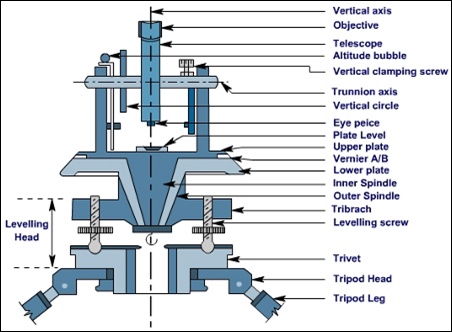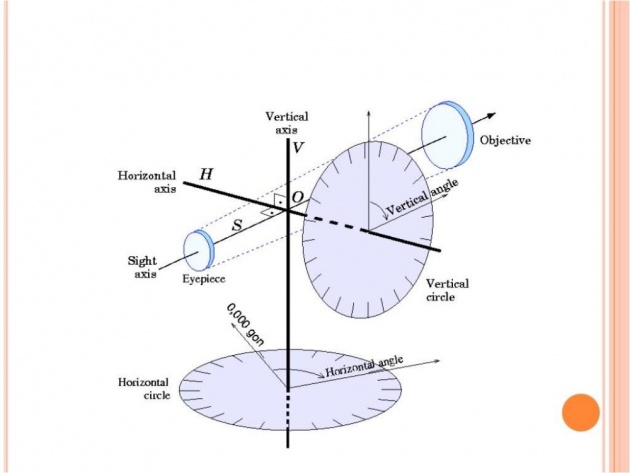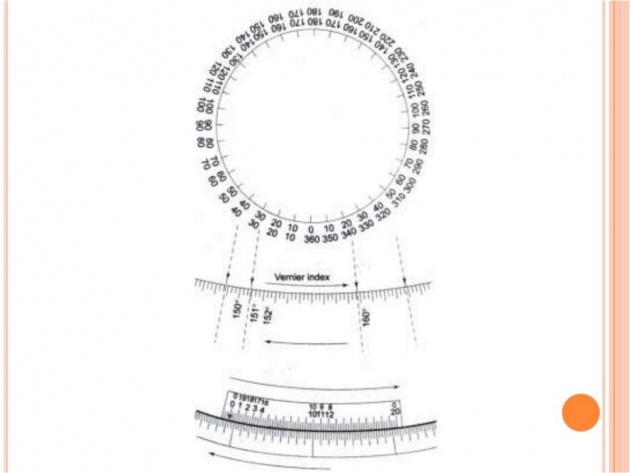THEODOLITE SURVEYING
Theodolite (Theod.): It is a most precise instrument designed for the surveying. Mostly used for the measurement of horizontal and vertical angles Has the wide application in surveying:Laying the horizontal angles Locating the points on the ground or on a line or circle / curve Prolonging the survey lines Establishing the grades (gradient) Carry out Levelling Setting out the curves, etc.
A theodolite may be a Transit Theod. or Non-Transit Theod Transit Theod: Line of Sight (LOS) can be reversed through 180o in the vertical plane Non-Transit Theod: It can not, i.e. LOS cannot be transited. Therefore, the latter type has become obsolete.
Components of Theodolite: (i) Telescope (ii) Vertical Circle (or Vernier Circle) V.C (iii) Vernier Frame: It supports the V.C from outside. (iv) A-Frame: It is an A-shaped outer-most vertical frame which supports whole the measuring assembly). (v) Levelling Head and Foot Plate (these are the two horizontal plates parallel to each other; Levelling Head lies above the Foot Plate). (vi) Two Spindles or Two Axes: These are the two inner and outer vertical supports which holds the assembly lying above the Horizontal Circle which also serves as a horizontal frame.

Important Definitions of Theodolite Work: (i) Face Left: When the Vertical Circle of a Theod is situated on the left of the observer and the observation or reading taken with this face is called Face Left Observation or Reading.(ii) Face Right: When the Vertical Circle of a Theod is situated on the right of the observer and the observation or reading taken with this face is called Face Right Observation or Reading. Taking the mean of the said two observations eliminates the Collimation Error. (iii) Transiting a Telescope or (simply) Transiting: Operation of turning the telescope through 180o about the Trunnion Axis. It is also called Reversing or Plunging of the telscope; LOS entirely gets reversed by the transiting. (iv) Telescope Normal: The telescope is said to be Normal or Direct when the Vertical Circle is to the left of the observer and Bubble is upward. (v) Telescope Inverted: The telescope is said to be Inverted when the Vertical Circle is to the right of the observer and Bubble is downward.(vi) Changing the Face: Operation of changing the face of telescope from Face Left to Face Right and vice-versa.(vii) A Set: It is a set of Horizontal Observations and (set) comprises two horizontal measurements one with Face Left and second with Face Right.(ix) Double Sighting: Process of measurement of horizontal or vertical angle twice; once with telescope in Normal Position and once with telescope in Inverted Position.

Temporary Adjustments of Theodolite: (i) Setting over a Station and (ii) Levelling the Theodolite Temporary Adjustments of Theodolite: (i) Setting over a Station: Centering over the station is done by a Plumb Bob or Plummet (in case of Electronic Theodolite) Rough levelling of whole the instrument with adjusting the Tripod Legs Second centering is done by Unclamping the Spindles and Second levelling is done by Bull-Eye centering(ii) Levelling the Theodolite: To make the vertical axis of Theod. truly vertical Levelling is done by (rotating) the Foot Screws with respect to the Plates’ Level (determined by the Spirit Bubble)Levelling Method: Levelling with Three Screws OR Levelling with Four Screws (if a Theod. has got the four screws; depending upon the provision of the screws). Both the methods have the same techniques of levelling (i) Rotate the two screws inside (of the instrument) with both the hands at a time and level the bubble of Spirit Level in the centre (by keeping the Spirit Level towards you, between the two screws) (ii) Then turn the Upper Plate through 90o, use the above technique (iii) Return to the first position, use the above technique (iv) Then turn the Upper Plate through 180o, use the above technique (v) Return to the first position and use whole the above-said method until the instrument has been completely levelled

.Measurement of Angles with Theodolite:
(i) Measurement of Horizontal Angles (ii) Measurement of Vertical Angles (iii) Measurement of Miscellaneous (other observations)(i) Measurement of Horizontal Angles:
(a) Direct Procedure: (i) Set up the instrument, say at point B Centre and Level it(ii) Release the clamp of Upper Plate; set vernier to read zero; clamp the plate(iii) Loosen the Lower Plate and sight (say) point A. Clamp the Lower Plate and accurately bisect A by using the Lower Tangent Screw. Read both the verniers and take the mean of two readings. (iv) Unclamp the Upper Plate and swing the telescope in clockwise direction until point C is sighted. Tighten the Upper Clamp and accurately bisect C by using the Upper Tangent Screw. (v) Again read both the verniers and take the mean of two readings. Difference in the mean of the reading noted at A and that at C is the angle ABC.(vi) Change the face of the instrument and repeat the steps from (ii) to (v) to measure the angle ABC on Face Right. (vii) Now take the mean of the two measurements for the angle ABC with Face Left and with Face Right; it will give the correct required angle ABC.Measurement of Angles with Theodolite:
(b) Repetition Method
: For a good accuracy, this method is used. Average horizontal angle is obtained by diving the final reading by the number of repetitions done. It is important that a small error in the Sine of angle causes a considerable error in the lengths of the sides. Consider an angle ABC.(i) Level and centre the instrument (keeping Face Left) over the point B.(ii) Set vernier to read zero. Loosen Lower Plate and move the telescope in azimuth (in clockwise direction; to measure the horizontal angle). Sight point A; accurately bisect point A by using the Lower Tangent Screw. (iii) Read both the verniers and take the mean of two readings. (iv) Unclamp the Upper Plate and swing the instrument in clockwise direction until point C is sighted. Tighten the Upper Clamp and accurately bisect C by using the Upper Tangent Screw. Note down the readings of verniers A and B to get approx value of angle ABC. (v) Unclamp the Lower Plate and swing the telescope clockwise to sight A again and accurately bisect A by using the Lower Tangent Screw. (vi) Unclamp the Upper Plate and swing the telescope clockwise to sight C again and accurately bisect C by using the Upper Tangent Screw. ) Repeat whole the process until the angle is repeated the required number of times Find out the average value with Face Right by dividing the final reading by 3.(viii) The average horizontal angle is obtained by taking the average of the two angles measured by the Face Left and Face Right.
(b) Reiteration Method: This method is very useful when there are several angles , β, γ, , etc. having a common vertex e.g. ‘ O ’. In this method, the angles are measured successively starting from a Reference Point / Station (e.g) A here and finally closing at the same point. This operation of taking the last observation on the same starting station is known as Closing Horizon. As a check, the sum of all the angles, say , β, γ and must be equal to 360o. This method is also known as Direction Method.
Let the instrument be stationed at the point i.e. station O. The AOB (), BOC (β), COD (γ) and DOA () are to be measured from the station O (having the theodolite stationed at this point).Steps for Reiteration Method: (i) Theod is centred and levelled at O(ii) Sight the station A using lower clamp and set the vernier to read zero. Clamp upper and lower plates. Read both the verniers and take mean of both the readings. (iii) Unclamp the upper plate, move the instrument clockwise and bisect the next station B accurately using the upper tangent screw. (iv) Read both the verniers and take the mean.(v) Similarly sight the station C and D one by one and then finally the station A. In each case, read both the verniers and take the mean. (vi) The angles , β, γ and are calculated by finding out the difference between the two consecutive readings. (vii) Transit the Theod, swing the instrument anti-clockwise and take the observations with Face Right to measure each angle. (viii) Average of the two readings with Face Left and with Face Right (for each angle) will give the true value of that angle. Example: + β + γ + = 80o 31’ 30’’ + 70o 54’ 20’’ + 85o 23’ 50’’ + 123o 10’ 20’’ = 360o



